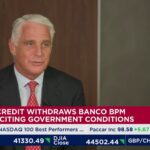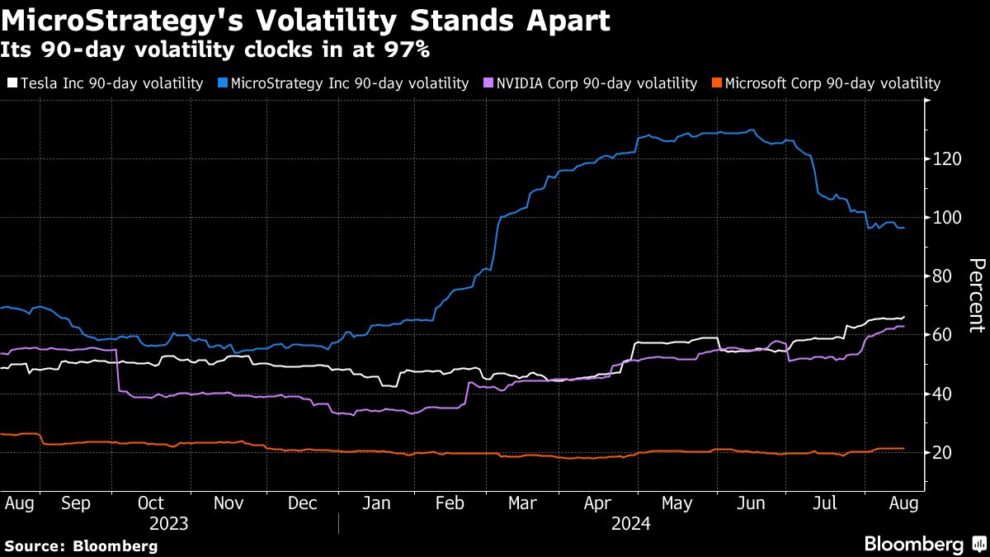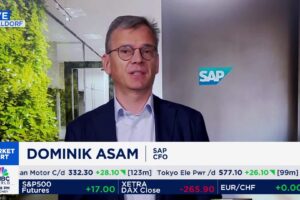
(Bloomberg) — In a part of the US market for exchange-traded funds that has become known for increasingly risky products, a new offering has debuted that stands out in the crowd.
Most Read from Bloomberg
Defiance, a $1.4 billion asset manager, on Thursday launched the Defiance Daily Target 1.75X Long MSTR ETF under the ticker MSTX. The fund looks to offer daily leveraged returns on MicroStrategy Inc. The stock, which has been seen as a Bitcoin proxy because of the company’s holdings of the digital token, has a 90-day volatility of about 97%. That would likely make the new ETF the most volatile in the US, according to Bloomberg Intelligence.
For comparison, the same volatility measure comes in at 66% for Tesla Inc. — another stock prone to sizable swings — and 63% for Nvidia Corp., data compiled by Bloomberg show. For SPY, the giant State Street fund that tracks the S&P 500 Index, it’s 14%.
MSTX is the latest entry in what’s become a robust roster of ETFs that use derivatives to offer juiced-up or inverse returns on single companies. As stocks roared higher for much of 2024, these funds have boomed in popularity, attracting billions of dollars and an array of issuers and new products. But investors in MSTX will potentially face the sharpest swings of them all, says BI’s Eric Balchunas.
“We’re currently in a hot-sauce arms race as more and more issuers look to push the envelope on volatility because there is a market for it,” he said, referring to a moniker he gives riskier funds.
Leveraged single-stock ETFs debuted two years ago, even as US Securities and Exchange Commission officials sounded the alarm on them, particularly for retail investors. While the funds offer a way to tap volatility, they can also compound losses. And though SEC Chair Gary Gensler said the products “present particular risk,” assets in single-stock ETFs have nearly doubled in each of the past two quarters and are currently around $8.5 billion, BI estimates.
“Leveraged funds tend to be used by tactical traders that understand that these funds may or may not come with heightened volatility,” said Sylvia Jablonski, the chief executive officer of Defiance.
The industry offers funds for all manner of assets, strategies and themes, and companies have been introducing ever-more-complex products to lure cash in a crowded field. Many are also able to charge more for the products given that larger competitors that typically charge less for their ETFs aren’t participating in leveraged and inverse funds, according to BI.
Read more from BI: ETFs’ Hot-Sauce Arms Race to Serve Up Most Volatile US Fund Ever
“Leverage single-stock products have clearly struck a chord with the trading crowd,” said Todd Sohn, an ETF strategist at Strategas. “Vanilla equity is a high hurdle to attract flows, so this is a new frontier, especially for smaller issuers trying to make a dent in the industry.”
‘Massive Magnet’
Eye-popping returns from the likes of T-Rex 2X Long NVIDIA Daily Target ETF (NVDX) and GraniteShares 2x Long NVDA Daily ETF (NVDL) — which have earned 330% and 290% in 2024, respectively — have caught investors’ attention. Assets in NVDL, for instance, have soared to $5 billion, from around $200 million to start the year. That growth has inspired other issuers to try their luck.
“It has become a massive magnet for all kinds of experimental products to be launched,” said Balchunas. “NVDL charges 1.15% — you just need one hit like this to be set for life.”
For investors, a wrong-way bet can be extra painful. While NVDX and NVDL are the top-performing ETFs this year, three inverse Nvidia funds also top the list of worst performers, with losses of more than 70% each. The T-Rex 2X Inverse NVIDIA Daily Target ETF (NVDQ) is down 90% this year, the worst record for a US ETF in the entire 3,600-fund universe.
“There is a reason why the front page of this fund’s prospectus is covered with disclosure in black bold print,” Amrita Nandakumar, president of Vident Asset Management, said of the new MicroStrategy fund. “As an industry, we have a responsibility to ensure that investors understand that funds such as these are meant to be short-term trading vehicles and not long-term investments.”
MicroStrategy became popular with retail investors in recent years thanks to its bets on Bitcoin. The firm’s CEO has said the digital asset was a better investment for the enterprise-software company’s cash than traditional staples such as short-term Treasuries.
Defiance — which is known for its thematic offerings — also recently launched a double-leverage Eli Lilly ETF. It also manages some options-income products and is hoping to introduce a 2x fund based on Broadcom Inc. in the coming days. It has also shuttered some offerings, including the Defiance Treasury Alternative Yield ETF, which it closed last month.
–With assistance from Katie Greifeld.
Most Read from Bloomberg Businessweek
©2024 Bloomberg L.P.










